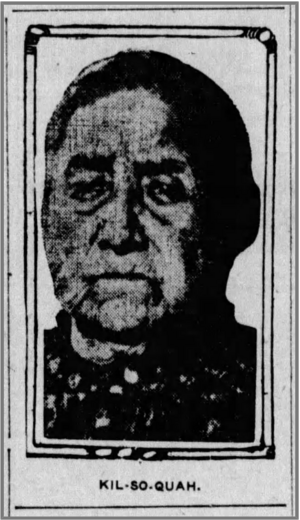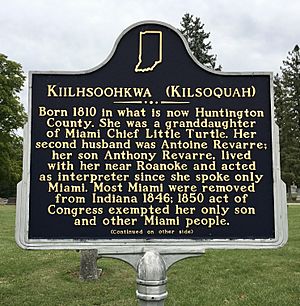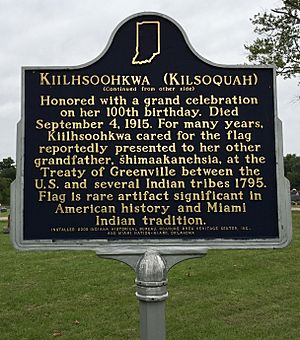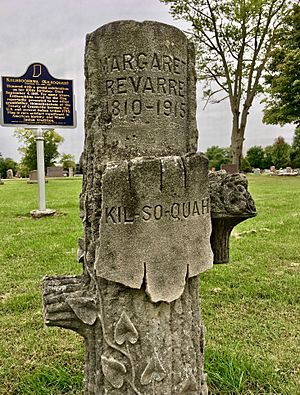Kiilhsoohkwa facts for kids
Kiilh-sooh-kwa was a special member of the Myaamia Nation. She was the granddaughter of the famous Myaamia Chief Mihšihkinaahkwa. Kiilh-sooh-kwa was born in 1810 and lived a very long life, passing away in 1915. She was one of the few Myaamia people who were allowed to stay in Indiana when many others were forced to move in 1846.
Contents
Growing Up: Kiilh-sooh-kwa's Early Years
Kiilh-sooh-kwa was born in 1810 in an area of northeast Indiana. She once said it was near where the town of Markle is today, in Huntington County. Other stories say she was born closer to Huntington.
Her grandfather was the well-known Myaamia Chief Mihšihkinaahkwa. Her father was Wok-shin-gah, also known as Crescent Moon, who was Little Turtle's son. Her mother was Nah-wah-kah-mo-kwa, or Snow Woman.
Family Life and Marriages
Kiilh-sooh-kwa first married John Owl in 1826. He was the son of Chief John Owl. They were married near the Eel River. Sadly, John passed away within a year or two of their marriage.
In 1832, Kiilh-sooh-kwa married Shaw-pe-nom-quah. He was also known as Anthony Revarre. He was a trader who was half Native American and half French. Kiilh-sooh-kwa and Shaw-pe-nom-quah had six children together. Four of their children died when they were very young. Their two children who lived were a son named Wa-pe-mung-quah and a daughter named Wan-nog-quan-quah.
Kiilh-sooh-kwa's Later Life and Legacy
We don't know much about Kiilh-sooh-kwa's life as a young adult. However, the Smithsonian Institution described her as an important midwife in Indiana. A midwife is someone who helps women during childbirth. She knew a lot about plants and how to use them for medicine.
In her older years, Kiilh-sooh-kwa lived in Roanoke, Indiana. She lived on a small piece of land that was part of her family's original territory. She only spoke her native Myaamia language. She was described as a big woman who often smoked a pipe. She was also a very religious Catholic.
A Welcoming Spirit and a Big Birthday
In 1915, a newspaper in Fort Wayne wrote about her. It said that if a stranger visited, she would shake their hand firmly. After looking them over, she would say a few words in her language. These words meant a warm welcome.
About 15,000 people came to Roanoke to celebrate her 100th birthday! This big event was written about in many Indiana newspapers.
Her Passing and Lasting Memory
Kiilh-sooh-kwa passed away on September 4, 1915, at her home in Roanoke. She had been sick for a few weeks. Her death was described as peaceful.
Her passing was seen as a big loss. People said she was "the last royal Miamis and the oldest resident of the State of Indiana." Her funeral was held at St. James Catholic Church in Roanoke. She was buried in Glenwood Cemetery in Roanoke.
Images for kids







